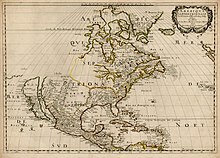History of the mapping of California
This article has multiple issues. Please help improve it or discuss these issues on the talk page. (Learn how and when to remove these messages)
|

Exploration of California by Europeans began in 1542 with Juan Rodríguez Cabrillo of Spain.[1] Although 16th-century maps correctly depicted California as a peninsula, many 17th-century maps depicted California as an island.[2] This error was not corrected until the mid-18th century.[3]
The first geologic mapping of California began in 1826.[4] Interest in plotting California's landscapes increased when gold was discovered in 1848.[5]
California quickly became a well-documented piece of the United States. Modern improvements to mapping technology, particularly GIS, have enabled every aspect of California to be recorded on a map.[citation needed]
History
[edit]

Chronology of early surveying and mapping efforts
[edit]In 1841, Cadwalader Ringgold, an officer in the United States Navy, spent twenty days surveying the San Francisco Bay watershed as a member of the United States Exploring Expedition In 1849, Cadwalader Ringgold began a more comprehensive survey the San Francisco Bay region,[6] the Sacramento River, and parts of the American and created several maps which included depth sounding information for the Sacramento River and San Francisco Bay. Also included on the maps are the sizes and locations of settlements along the Sacramento River.[7] A Series of Charts with Sailing Directions, by Cadwalader Ringgold was published in 1852. This book includes the maps from the 1849 expedition and color illustrations of ports and important landmarks. To further supplement the navigators, the book includes notes on observed magnetic variation and a table of 26 coordinates for landmarks, harbors, and a table of bearings for several point-to-point journeys.[8]
In 1857, the commanding officer of the United States Coast Survey Steamer, Active, discovered a deep submarine valley, or "gulch", in the center of Monterey Bay. This was the first known sea-floor canyon and is now called Monterey Canyon.[citation needed]
From the 1850s through the 1860s, the United States Coast Survey, now NOAA's Office of Coast Survey, published a set of color maps with five stratigraphic units detailing the geologic makeup of California as well as a comprehensive set of nautical charts for the entire coast of California.[9]
Shortly after statehood, the California state government appointed its first State Geologist and began commissioning geologic surveys of its own. The state appointed John B. Trask to the position of State Geologist, and he served from 1850 to 1856. He compiled a report titled "On the Geology of the Sierra Nevada, or California Range." The second State Geologist, Josiah Whitney, served from 1860 to 1873. Whitney organized the first comprehensive survey of California, and the first complete topographic maps of the state were completed under him. Mount Whitney, the tallest peak in California is named after him.
The State Mining Bureau was established in 1880, and the position of State Geologist was changed to State Mineralogist. In 1891, the first state geologic map showing eight color stratigraphic regions was published. The second geologic map of the state was published in 1916 and shows twenty-one stratigraphic regions. The State Mining Bureau was renamed the Division of Mines and Geology in 1862. Its pseudonym, the California Geologic Survey, was established in January 2002. [10]
In 1869, George Davidson, an assistant coast surveyor compiled the book Pacific Coast: Coast Pilot of California, Oregon, and Washington Territory. The 262-page volume is complete with illustrations, coordinate tables, notes on magnetic variation, and some bathymetric sounding information.[11]
The first maps of California's vegetation were produced at the end of the 19th century.[12]
Modern projects
[edit]
Surveying efforts in California continue today with the assistance of modern technology. Modern mapping in California involves using modern electronics to refine information found through analog methods. Many organizations and government agencies are involved in collecting and mapping data in California today.
See also
[edit]Mapping legislation
[edit]- Alquist Priolo Special Studies Zone Act
- Surface Mining Control and Reclamation Act of 1977 (SMCRA)
- Seismic Hazards Mapping Act
References
[edit]- ^ Bacich, Damian. "Early Exploration of California (Part 1 of 2)". California Frontier Project. Retrieved 22 November 2024.
- ^ "California as an Island in Maps". Stanford Libraries. Retrieved 22 November 2024.
- ^ Haven, Cynthia. "California Dreaming". Stanford Magazine. Retrieved 22 November 2024.
- ^ "History of The Geologic Map of California". California Department of Conservation. Retrieved 22 November 2024.
- ^ "Mapping a Changing California: Selections from the Seventeenth to the Twentieth Century". California Historical Society. Retrieved 22 November 2024.
- ^ Houston, Alan Fraser, "Cadwalader Ringgold, U. S. Navy" an article in California History magazine, Volume 79, Issue 4, Winter 2000, page 208.
- ^ Ringgold, Cadwalader. "Chart of the Farallons and the Entrance to San Francisco Bay..." David Rumsey Map Collection.
- ^ Ringgold, Cadwalader. A Series of Charts with Sailing Directions. J.T. Towers, 1852. Original from the New York Public Library. Google Books [1]
- ^ Office of Coast Survey Historical Map & Chart Project, Search:"California, Nautical Charts." http://historicalcharts.noaa.gov/historicals/historical_zoom.asp
- ^ History of the California Geological Survey. State of California, Department of Conservation. [https://web.archive.org/web/20081225150923/http://www.conservation.ca.gov/CGS/Pages/aboutUs.aspx Archived 2008-12-25 at the Wayback Machine
- ^ Davidson, George. Pacific Coast: Coast Pilot of California, Oregon, and Washington Territory. Government Print Office, 1869. Google Books, [2]
- ^ Keeler-Wolf, Todd (2007). "The History of Vegetation Classification and Mapping in California". Terrestrial Vegetation of California. By Barbour, Michael (3rd ed.). Oakland: University of California Press. pp. xviii–42. ISBN 9780520249554. Retrieved 22 November 2024.
External links
[edit]Mapping projects in California
[edit]State government agencies mapping projects in California
[edit]Non-government organizations mapping projects in California
[edit]- California Coastal Records Project – A photographic survey of the California Coastline, free to use. See Wikipedia article: California Coastal Records Project.
Bathymetric Data of the California Coast
[edit]General California Map Links
[edit]- NOAA Office of Coast Survey Historical Map and Chart Project
- The University of Alabama Map Collection
